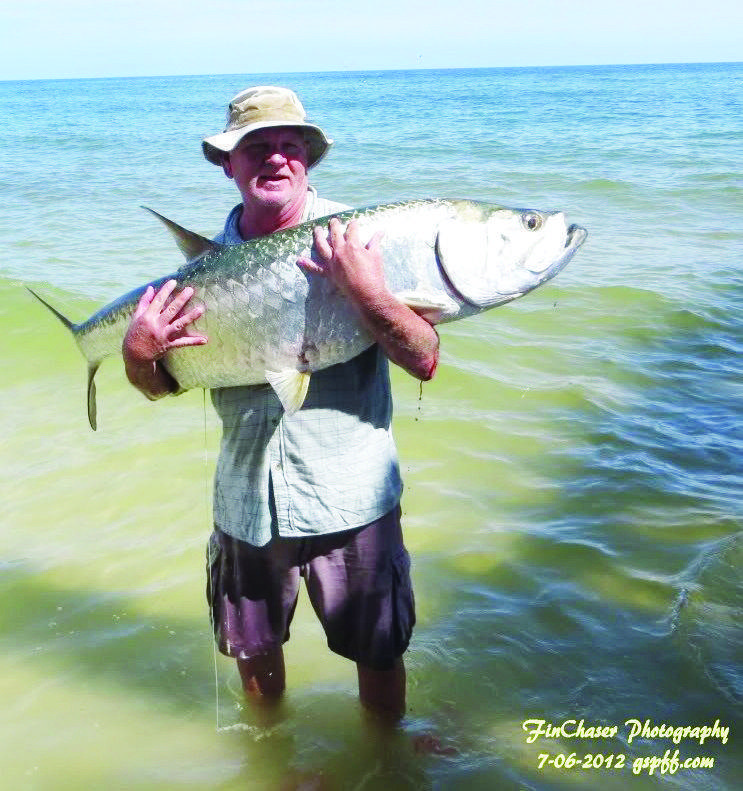[dropcap]”H[/dropcap]otter than a 4th of July firecracker” usually describes the weather this month for the shore bound angler from Orange Beach to Dauphin Island. But savvy anglers willing to wake up well before daylight and get their fishing in before the sun rises high and scorches the crowds of beachgoers arriving by 9am often have plenty of room and more comfortable conditions in which to fish.
July offers the full summer variety of fish from the beach or pier, but the best opportunities are often early and late in the day. The annual tarpon migration should be in full swing this month and spotting cruising schools of the ‘silver kings’ is a common sight from the Gulf State Park Pier in Gulf Shores. In fact a pretty fair number of tarpon are hooked each summer from the pier by anglers targeting king mackerel fishing with live LYs (Scaled sardines and False herring) or even dead bait (cigar minnows) or lures. Spinning tackle on 7 to 9 foot rods with 250-300 yards of 15#-20# line is standard issue for these anglers. Also, some of the largest kings of the year (25#-40#) are caught from the pier in July as well as spanish mackerel, bonita (Little Tunny), jack crevelle and bull redfish which occasionally show up in large schools around the pier in a feeding frenzy. This, along with the usual excitement from marauding sharks, migrating tarpon and cruising cow-nosed rays or passing bottlenose dolphins creates a visual sight not soon to be forgotten.
Smaller gamefish are even more plentiful on the pier (shore or jetty) and anglers can test their light tackle skills on the ever present ladyfish (skipjack), bluefish, blue runners (hardtails) and spanish mackerel by using most any half ounce lead head jig (though white and yellow are best) or with the ever popular “bubble rig” sold in bait shops.
A leader of some heavy monofilament or light wire is usually necessary especially when the toothier bluefish and mackerel are around. And don’t forget the dehooker or needle-nosed pliers for hook removal. Most of these fish that are not the best table fare are good candidates for catch and release fishing, even in the warmish summer water. Just about any bass or walleye class tackle in the 8# -12# class is suitable for this type of fishing.
Another great alternative fish on the pier or jetty is the Atlantic spadefish which can often be seen in schools swimming around the pier. All that is needed to catch them is a tiny (#6 or #8) bronze colored single hook buried in a small piece of shrimp tipped with a sliver of pink or orange Fish Bites with just enough weight to hold the bait a few feet under the surface near the pilings. A small Styrofoam float seems to help as a bite indicator and to hold the bait about 3’-6’ deep. These ‘striped sea bream’ are nibblers and great bait stealers but are scrappy fighters for their size and pretty good eating when fried or baked whole or large enough to fillet. Most weigh about ½ to ¾ of a pound but each summer many in the 4 to 6 pound class are caught from the pier.
July shore anglers still have a good chance to catch whiting, pompano, and speckled trout, slot sized redfish, flounder and bluefish along with many other species that are usually found along the beaches out to the sandbar. When the gulf waters are calm, early mornings often offer a short but very active period of action from many of these fish using a variety of artificial lures especially top water lures (like bone or ‘Halloween’ colored She Dog, and pink Skitterwalk). If top water baits are not producing, often subsurface shallow-lipped jerk bait (like a red and white Bomber, Rapala X-Rap or Yozuri Crystal Minnow) will get their attention. And there’s always the plastic minnow imitations (like pearl Zoom Fluke or natural colored Fin-s lures) on a light weight jighead (1/8 to ¼ ounce) that catch a lot of fish as the angler swims or drops it through the water column, or jigs it off the bottom. And don’t overlook the Gulp Shrimp which is often even more effective in rough or dingy waters due to the scent. We have found that flounder are very fond of the New Penny and Molting colors. Just tie on a ¼ ounce jighead and slide one on, then cast it out into the trough between the bars and slowly drag it across the bottom with occasional ‘hops’ to get the fishes attention. They often hit it as it settles back toward the bottom.
Just keep an eye out above for fast building thunderstorms that bring ‘killer lightning’. The open beach is NOT a good place to be in a storm, especially when holding a graphite rod! And watch where you step when wading in the water. Most everyone thinks “SHARK!”, and they can be in shallow water (usually early and late in the day or at night), but more anglers are struck by stingrays each year and many more are stung by jelly fish (sea nettles and even moon jellies). So keeping some ‘Sting Ease’ in your tackle pack when wade fishing might save your day or at least make a jellyfish encounter a bit less painful.

